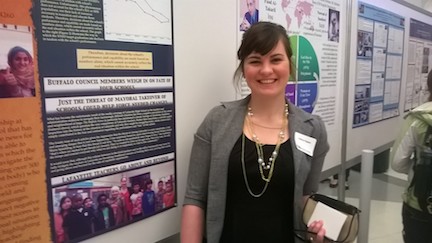By Kelly Coughlin
Lafayette High School in Buffalo, New York, is known for being a failing school. Year after year, test after test, student after student, Lafayette just can’t get the numbers it needs to move out of the red. So, when Audrey Foppes—a 2015 graduate of the State University of New York at Buffalo and member of Phi Beta Kappa—was planning her senior thesis work in the Buffalo Public Schools, she might have avoided Lafayette entirely. A less enthusiastic student might have passed it by, but for Foppes, Lafayette was the place to be.
Buffalo is home to a diverse array of refugee populations, and many refugee students attend Lafayette. For someone like Foppes, that is, someone with an interest in ESL education, the diversity of a school like Lafayette makes it the perfect place to learn.
“The kids, of course, were just astonishing,” Foppes says. Her words convey awe and admiration, two sentiments that seem out of place in a description of students from a failing school. It is easy to look at the numbers, hear the world failing, and picture that kid from high school who was seen in class only on the rarest of occasions. It is easy to look at the numbers and simply say that the students are failing. That, according to Foppes, is not the case.
The students “not only wanted to learn, but needed to learn,” says Foppes.
“We require our kids to go to school,” she explains—“we” meaning residents of the United States.
To the average American student, school is ordinary; saying you go to school seems mundane. From a broader perspective, the opportunity to go to school is anything but. The mundane reality of life as a student in the US is an unimaginable luxury in other parts of the world. A bus to get you there safely sounds like pure fiction.
For the refugee students Foppes worked with at Lafayette, school was extraordinary, and the sentiment showed. The issue with Lafayette High School is less its students than its methodology.
Foppes explains it as follows: Each year, the state tells schools that a certain number of students must achieve a certain score on the final, standardized exams in order to have a passing grade for the school. If a school fails, as Lafayette has numerous times, they have to strategize to show how they intend to improve. The next year, the same school will need a larger percentage of students to pass to have the label of failing school removed. Because a school that is testing new teaching strategies is unlikely to improve that dramatically in a single year, it will likely fail again. The hole just gets deeper.
“It takes two to three years to pick up conversational language, five to seven to pick up academic language,” Foppes explains.
If this is the case, how can students be expected to perform on standardized tests when they have been in the US for as little as a few weeks? Foppes found herself asking this exact question.
“It is not like September starts, and you have all your students—you have students who a month before showing up in school were elephant herders in Thailand,” Foppes exclaims. The effort she puts into explaining the issues plaguing standardize testing is a signature of passion, but in this case, it might also be pure exasperation.
Every student enrolled is required to take the proficiency exams, regardless of how long they have been in school. They are dealing not only with moving to a new country, but also with PTSD from leaving war-torn countries and the culture shock of arriving somewhere vastly different from the homes they have known.
“People think food and clothes and music when they think culture shock, but that is only the surface,” Foppes says. “In reality, you may be working with students who are anxious in school because they are accustomed to spending most of their time outdoors, and being trapped in a room for hours at a time is unsettling.”
The solution to these problems will not be simple. A one-size-fits-all fix is not going to work.
“They profess don’t use blanket policies,” Foppes says, “so they make a blanket policy for diversifying.”
This reality is clearly tiresome for someone who has been in the trenches. But in a society so accustomed to instant gratification, no one wants to hear that the solution will take ten years to work. Thus, the default is an overarching policy to serve as a miracle cure for the issues within the educational system at large.
Foppes has other ideas.
“Step back,” she says. “In this school, in this classroom, what can be done to help these kids?” To her, it means working with teachers in a way that doesn’t make them worry about their jobs.
This approach makes sense: No one would want to ask questions if doing so means they are incompetent. No one would want to make noise when they know someone will be losing their job. Placed in this situation, teachers might feel like they have to make a choice between risking their own position or risking the quality of the education they provide.
Foppes recalls one teacher in particular who attempted to use translanguaging to aid in a simplified mathematics curriculum. Translanguaging uses a student’s first language to strengthen their acquisition of a second by writing a word in the first language, then again in English to help students learn English. The problem was many students were not literate in their first language. One activity ended up taking multiple weeks, and much of the time Foppes spent assisting the teacher was spent looking up words for students in their first languages.
Even just figuring out what language to look for was a challenge.
“[You might have to] search the language of the Congo, then the language of the South Congo” Foppes says. And so it goes.
The underlying issue: With numerous languages spoken in each country, you cannot just ask a student where they are from and instantly know what language they need. In some cases, as Foppes mentions, a child might not know the formal name of their own language.
“If you can figure our what it is, are there resources for it? And what is the point if they aren’t literate anyway?” Foppes says, rattling off the questions she would ask herself.
The biggest issue: Why are students spending two weeks coloring…in math class?
“The way to go about describing these complex topics and concepts and theories is to simplify, from the ground up, keeping in mind that your students don’t speak English,” Foppes says.
In contrast, it doesn’t mean reverting to a kindergarten level, particularly when some students might be fully proficient in their native language. Many, however, have what Foppes calls “interrupted formal education.” This means that they are not at the learning level in school suggested by their age or grade-level.
Assessing a student’s abilities is difficult when language cannot be used as a gauge. Proxy measures for intelligence can be used—Foppes notes that one might consider the ability to play the piano a sign of high achievement—but are not necessarily applicable to refugee students.
“Without any of those references, all we have for these kids is their language ability, but it is their second language,” Foppes says.
The point Foppes is making is that effective strategies take time to develop, and schools like Lafayette have a shortage of time to improve. When annual assessments require Lafayette to overhaul its methods, the school is less likely to be successful. It takes time to test new methods, and teachers who are concerned about their jobs are unlikely to admit that they are having difficulties. All of this prevents students from reaching their potential.
“The students come first,” Foppes says, “no matter when your election year is, and no matter if you’re getting tenure or not.”

Above: Audrey Foppes (ΦBK, SUNY Buffalo, 2015) presents her work with immigrant students at Lafayette High School, part of her senior thesis on ESL teaching and learning.
Kelly Coughlin is a senior at the University at Buffalo majoring in Biological Sciences and minoring in English. UB is home to the Omicron of New York Chapter of Phi Beta Kappa.




